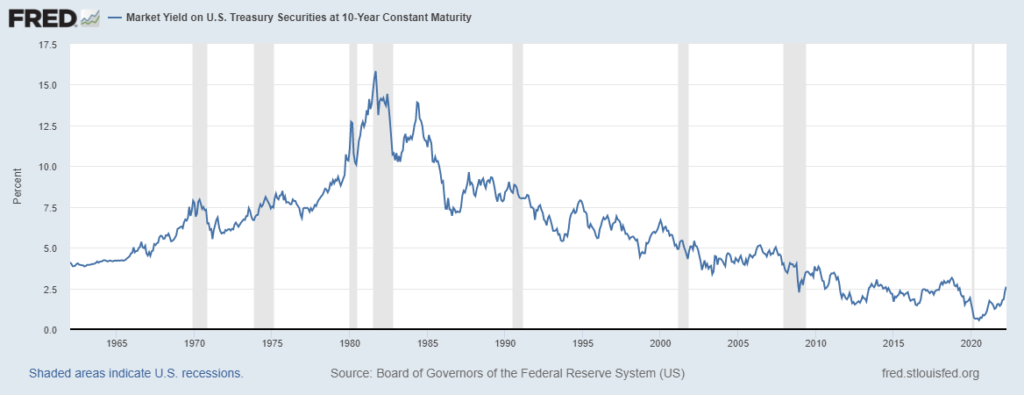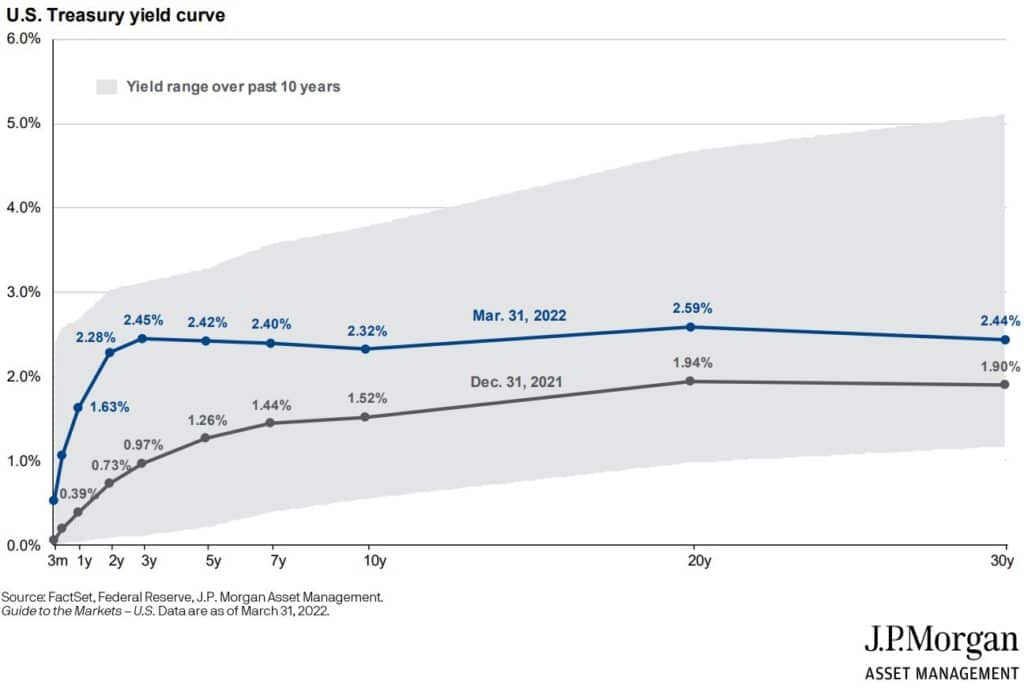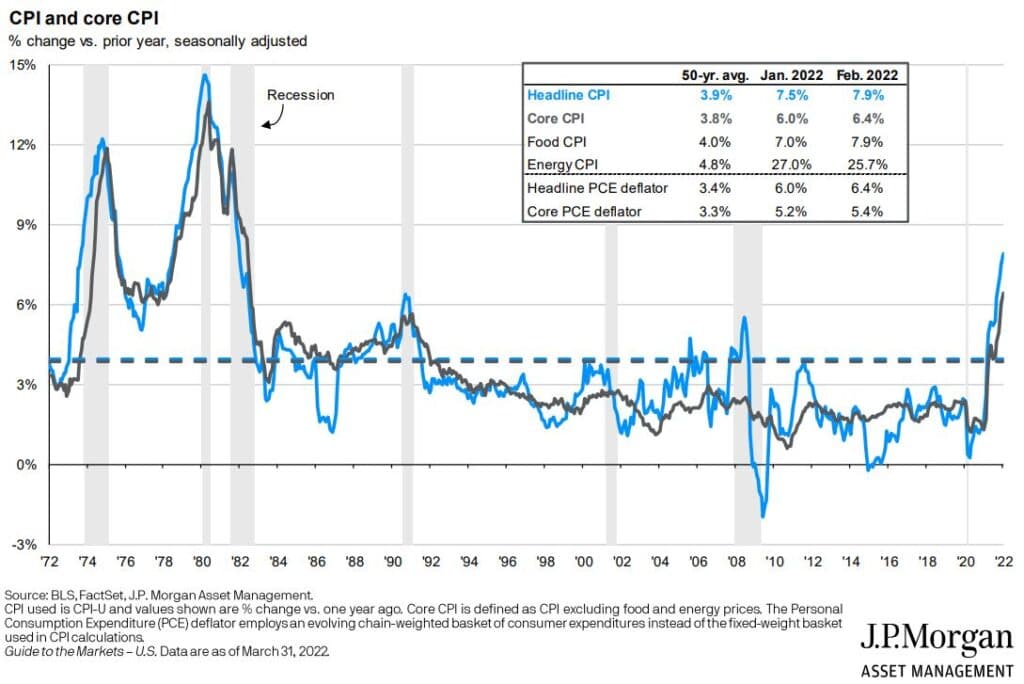
Dear Clients:
We explained in our Q4-2021 Client Letter (January 12, 2022) why we believed 2021 was a high-return, low-volatility “unicorn.” Our counsel was to expect more modest returns in 2022. Additionally, with the Federal Reserve (“Fed”) poised to begin removing emergency stimulus measures implemented at the start of the pandemic-induced economic shutdown in early 2020, investors should fasten their seatbelts for what could be a much rougher ride.
We didn’t necessarily think this would unfold over the next few weeks, but that’s what happened as investors grappled with inflation surging to levels not seen in 40 years, worries the Fed will not be able to tame inflation without pushing the economy into recession and Russia’s invasion of Ukraine.
After peaking on the January 3 (the first trading day of 2022), the S&P 500 (“SPX”) proceeded to enter “correction” territory (drop of 10-19.9%) on February 22 before bottoming on March 8 (down 13%). Bespoke Investment Group calculated the first fifty trading days in 2022 were the fourth worst start to a year since the inception of the SPX in 1928. The stock market roller coaster ride continued, as the SPX then rallied 11% through March 29.
The formerly high-flying NASDAQ Composite peaked on November 19, 2021 and bottomed on March 14, having suffered a “bear market” decline of -21.6%. Similar to the SPX, the NASDAQ index experienced a bounce of 16% through March 29.
After all that, we feel fortunate the SPX posted a total return of -4.6% for the first quarter of 2022, a relatively modest loss that masked the extreme turbulence investors experienced during the three months. In addition, according to Strategas Research Partners the average stock in the SPX has already experienced a “bear market” decline of 20% from its 52-week high.
“Value” trounced “Growth” in Q1-2022
| Total Returns as of March 31, 2022 | 3-months | 12-months |
| S&P 500 | -4.60% | 15.63% |
| S&P 500 — Value | -0.17% | 12.54% |
| S&P 500 — Growth | -8.60% | 18.15% |
| NASDAQ Composite | -8.94% | 8.09% |
U.S. stocks stumbled in the first quarter of 2022, as the yield on the 10-year U.S. Treasury bond surged from 1.44% at the end of 2021 to 2.36%, the 92-basis point (0.92%), a 64% increase in three months’ time. Investors are clearly unnerved by inflation that remains at sky-high levels not seen since the early 1980s and expectations this will cause the Fed to be much more aggressive in raising interest rates than had been forecast at the beginning of the year. Against this backdrop, it’s not surprising stocks sold off in early 2022 after a strong 2021 and the damage was far greater in “growth” stocks, whose higher P/Es make them more vulnerable to higher interest rates.
Volatility returned with a vengeance in Q1-2022
Stocks went from soothingly calm in 2021 (the SPX had only 55 days when the index rose or fell by 1% or more) to stomach-churning in the first quarter of 2022, as if “Mr. Market” had flipped a switch. According to Bespoke Investment Group, the SPX rose or fell by 1% or more on fully 50% of trading days in Q1-2022, the fifteenth most for any quarter since 1945 (300+ quarters). Further, while a 10% move in either direction is rare within a given quarter, seeing 10% moves in both directions has happened in only eleven quarters since 1945. Past performance is no guarantee of future results, but Bespoke examined subsequent returns and the good news is the next quarter was positive ten out of eleven times (median return 14.9%) and a year later was positive all eleven times (median return 26.7%).
Bonds are supposedly “safe,” but had an epically bad Q1-2022
| Total Returns as of March 31, 2022 | 3-months | 12-months |
| U.S. Treasury (1-3 Years) | -2.50% | -3.11% |
| U.S. Treasury (7-10 Years) | -6.37% | -3.99% |
| U.S. Treasury (20+ Years) | -10.63% | -0.95% |
Conventional investment wisdom is stocks are “risky” and bonds are “safe.” Owning stocks is exciting—you can make or lose a bundle. Bonds are boring—you don’t make much, but you can’t lose money, either.
Governments and corporations borrow by issuing bonds, which are a contract between the borrower and lender spelling out the timing and amount of interest to be paid (i.e., the “coupon”) and when the principal amount borrowed is to be repaid (i.e., the “maturity”). Because the amount and timing of the cash flows are contractually set, bonds are referred to as “fixed income” investments.
Although the cash flows are fixed by contract, the price of a bond will fluctuate based on interest rate risk and credit risk.
For the past 40 years, the conventional wisdom has been generally correct. The graph below shows the yield on the benchmark 10-year U.S. Treasury Bond (UST) declined from a high of 15.8% in September 1981 to 0.6% in July 2020, as the pandemic crushed economic activity. Mortgage rates track the 10-year UST, so that’s why U.S. homeowners have benefitted from both the lowest rates in history and the related surge in property values.
When interest rates are falling, a borrower can offer new bonds with a lower coupon than the higher coupons on bonds issued in the past, making the fixed income stream on existing bonds more valuable and causing bond prices to go up. Conversely, when rates are rising, existing bonds go down in price. The longer the maturity of the bond, the more sensitive the price to changes in rates. Thus, bond investors have enjoyed a glorious, mostly uninterrupted bull market for the past four decades. Sweet!

Alas, bond investors learned in the first quarter of 2022 all bull markets eventually come to an end and it’s possible to lose more money in an asset class traditionally known for its safety than in stocks, with the April 1 headline in The Wall Street Journal blaring, “Bond Market Suffers Decline Not Seen in Over 40 Years.” That’s no April Fool’s joke.
We try to mitigate interest rate risk by keeping the duration (an indicator of how sensitive a bond’s price is to interest rate changes) of our fixed income portfolio low. To implement our strategy, we utilize Invesco’s BulletShares product, which are defined-maturity bond ETFs. This product is different from a conventional bond fund, which typically owns bonds with a variety of maturity dates and doesn’t hold any to maturity, which leaves the investor fully exposed to falling prices in an environment of increasing rates.
By contrast, a defined-maturity bond ETF like BulletShares holds bonds all maturing in the same year, all of which are held to maturity. Credit risk mitigated by the ETF holding a diversified portfolio of hundreds of individual bonds, so similar to an individual bond, the investor is able to hold the asset to maturity and receive the repayment of principal at “par” (100 cents on the dollar). In other words, as long as we’re confident we’ll receive par at maturity, we’re not worried about what happens with the price before maturity. BulletShares allow us to build shorter-term “ladders” of BulletShares maturing in consecutive calendar years. By keeping maturities short, we keep the duration of the portfolio low and minimize exposure to interest rate fluctuations, while at the same time having better liquidity than with an individual bond.
With rates rising, we have been waiting to reinvest funds from maturing investments. We’ll do so when we feel the risk/reward is positive, but plan to maintain a low duration for the portfolio.
“Inverted Yield Curve” for bonds spooking equity investors
Besides the dramatic rise in yields, there was a narrowing of the gap between long- and short-term Treasury yields. The difference between the two began to shrink in a trend known as a “flattening yield curve.”
Investors lend money to the government by buying bonds that “mature” (i.e., date the principal or amount you lent comes due) at various points in the future. The yield curve simply plots the yield (i.e., interest rate) on U.S. Treasury securities from shortest- (3-months) to longest-maturity (30-years).

Most of the time, the yield curve has a positive slope, which means longer-maturity securities have a higher yield compared with securities with shorter-maturities. The reason for this is when the economy is growing, investors holding longer-maturity securities assume increased risks of inflation, which can lead to the Fed raising interest rates. Bond prices go down when rates go up and the longer the maturity, the more sensitive the price is to a change in interest rates.
However, occasionally the yield curve “inverts” as long-term rates fall below short-term rates. This inversion occurs when investors believe the economy is slowing, leading to expectations for lower inflation and the Fed reducing interest rates.
You may have heard the talking heads in the financial media breathlessly warning of the potential dire consequences of an inverted yield curve. This is because many investors view an inversion as an infallible predictor of an impending economic recession, but it’s not. While it’s true each of the seven recessions since 1962 was preceded by an inverted yield curve, there were also instances when an inverted yield curve was not followed by a recession. Every trout is a fish, but not every fish is a trout.
Bespoke has examined past yield curve inversions and subsequent economic performance. According to their research, when just a few points along the yield curve invert, the probability of a recession barely increases. Further, it isn’t until the majority of the points on the curve invert that a recession in the next two years becomes increasingly inevitable. Bespoke reported just 7% of the points they track on the yield curve have inverted, so that doesn’t presage a recession. Further, the points on the yield curve that have historically been the best predictors of recession all remain sharply positively-sloped.
We’ll be monitoring the shape of the yield curve closely for clues, but at this time the near-inversion of the 2-year vs. the 10-year Treasury the talking heads are screaming about as the recessionary bogeyman is not particularly telling, on its own.
The Fed’s posture has pivoted rapidly to “hawkish”
The Fed utilizes “monetary policy” to control the cost and availability of credit to promote two primary goals; “full” employment and stable prices. In early 2020, the pandemic brought our economy to an immediate and unprecedented standstill, threatening the worst crisis since the Great Depression. The Fed quickly revisited its playbook from the Global Financial Crisis of 2008, slashing short-term interest rates to zero (from 1.50%-1.75%) and restarting “quantitative easing” (“QE”), purchasing $80 billion of U.S. Treasury Bonds and $40 billion of mortgage-backed securities in the open market each month. This constant buying supported bond prices and kept longer-term interest rates low.
These two actions combined to make credit both cheap and abundant. Fast forward two years and our economy has recovered, inflation is stubbornly high and asset prices have soared. President Biden nominated Fed Chairman Jerome Powell for a second term on November 21, 2021. The following week Powell told Congress that inflation was probably not “transitory” (self-correcting), a clear signal to investors the Fed was preparing to wean the economy from the emergency measures by raising its target for short-term interest rates and halting bond purchases.
The consensus expectation was for the Fed to gradually boost its target for short-term interest rates in a steady series of 25 basis point (0.25%) bumps. Indeed, the Fed halted its program of “quantitative easing” in March and on March 16 boosted its target for “fed funds” from 0%-0.25% to 0.25%-0.50%.
Inflation has been persistently high and at levels not seen since the early 1980s, leading to fears the Fed will need to slam vs. pump the brakes to bring it under control. There has been increasing talk of the Fed possibly “front-end loading” rate increases with 50 basis point (0.50%) bumps. Fed Governor Lael Brainard (nominated to become Vice-Chair) added fuel to the fire when she said on April 5 the Fed “will continue tightening monetary policy methodically” and will “start to reduce the balance sheet at a rapid pace as soon as our May meeting.”

While investors expected an end to “quantitative easing,” it was an unpleasant surprise to learn the Fed could soon throw the transmission into “reverse” by switching to a program of “quantitative tightening” (rapidly shrinking its portfolio of bonds, to the tune of a maximum of $60 billion of U.S. Treasury Bonds and $35 billion of mortgage-backed bonds each month). Indeed, the yield on the 10-year U.S. Treasury immediately jumped to 2.60%, a level not seen since 2018 and 2019.
Summary
Our expectation continues to be for more modest returns and increased volatility than experienced in 2021. We believe over long periods of time, stock prices track with corporate profits. Following 2021’s stellar increase from Covid-ravaged 2020, we still think corporate profits can grow at a high-single digit rate in 2022. As always, there will be headwinds, this time including continuing high inflation, stressed supply chains and a tight labor market. Of course, even if earnings come through, there’s the matter of what multiple investors be willing to pay in a rising rate environment.
Uncertainty is uncomfortable, but it’s something we’ve dealt with every day for the past 46+ years. We can’t predict specific events or their timing. For example, we cannot predict when the next recession will hit, how deep it will be, how long it will last or how stocks will respond. But in our plans, we account for the fact recessions and bear markets will occur—we don’t assume bull markets and sunny skies at all times. In other words, while we can never plan for the unexpected (like wars), the unexpected happening is always part of our plan.
Regulatory Update
Kirr, Marbach & Company, LLC (KM) is registered with the U.S. Securities and Exchange Commission (“SEC”), which requires advisers to file Forms ADV-Part 1, Part 2A (“Brochure”), Part 2B (“Brochure Supplements”) and Part 3 (“Form CRS-Client Relationship Summary) electronically on the Investment Adviser Registration Depository (www.iard.com). KM filed its annual updating amendments to its Forms ADV-Parts 1, 2A and 2B on March 22, 2022. In addition, KM filed an amendment to its Form ADV-Part 3 on March 22, 2022.
Form ADV-Part 2A is a narrative disclosure of an adviser’s business, written in “plain English.” The SEC mandated the headings, specific topics to be covered and the order of presentation.
If you would like a printed copy of KM’s ADV-Part 2A “Brochure” (or ADV-Part 1, Part 2B or Part 3), please contact Matt Kirr, Director of Client Service ([email protected]), Zach Greiner, CFP, Associate Director of Client Service ([email protected]) or Maggie Kamman, CFP, Associate Director of Client Service ([email protected]) at 812-376-9444 or 800-808-9444 and they’ll be happy to mail to you. Alternatively, you can find KM’s ADV-Part 2A and Part 3 posted on our website here.
Regards,
Kirr, Marbach & Company, LLC
Past performance is not a guarantee of future results.
The S&P 500 Index is an unmanaged, capitalization-weighted index generally representative of the U.S. market for large capitalization stocks. This index cannot be invested in directly.
The S&P 500 Value Index is an unmanaged, capitalization-weighted index that measures the performance of the value segment of the U.S. market for large-capitalization stocks. This index is a subset of the S&P 500 Index and cannot be invested in directly.
The S&P 500 Growth Index is an unmanaged, capitalization-weighted index that measures the performance of the growth segment of the U.S. market for large-capitalization stocks. This index is a subset of the S&P 500 Index and cannot be invested in directly.
The NASDAQ Composite Index is an unmanaged, capitalization-weighted index that measures the performance of more than 3,000 securities that are all listed on the NASDAQ stock market. This index cannot be invested in directly.
Subscribe
Subscribe to stay up to date with the latest news, articles and newsletters from Kirr Marbach.













